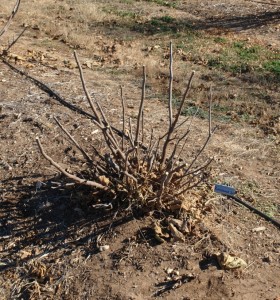Now that plants are finaly in rest, its time to take cuttings from those we most easily propagate from dormant woody cuttings. Figs are among the most easily propagated of all fruit crops. We don’t use rootstocks with figs, so just own rooted cuttings do fine. Fig trees themselves do better if they are tip pruned during the dormant season to remove apical dominance and encourage lateral growth the following growing season. The terminal plant material left after these cuts are ideal for propagation. Below is a photo of ‘Rattlesnake Island’, one of our local favorites that has been tip pruned.
Once we find out how much, if any winter injury the plant receives this winter, we will probably remove some of these shoots to allow more sunlight interception by the remaining shoots. Remember, dormant pruning is an invigorating action. So, after pruning, we bundle and label the dormant terminal cuttings and place them in a callus box. Figs are sub-tropical and really do not need any appreciable amount of winter chilling, so we don’t need to put these cuttings in the cold room for any length of time. We do with grape cuttings. So, the callus box is made up of media that resists fungal growth. We use either cedar cell, the remnants of fine cedar grindings after oil has been extracted, or cypress mulch, which resists rot, holds a sufficient amount, but not excessive water. If you can’t find either of these, perlite works ok too. We keep the callus box about 80°F until callus tissue forms at the base of the cuttings. We then stick them in pots and put them in the greenhouse. Below is a box with cuttings shown ready for the callus process to begin.
Drop me a line at j-kamas@tamu.edu if you have any questions, or feel free to leave comments on the blog.
-jim


